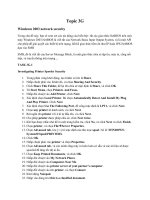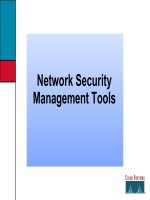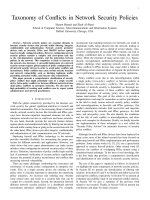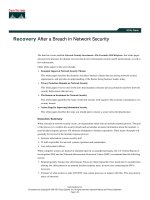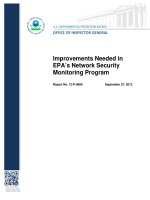Concepts in Network Security: LTC Ronald Dodge, Ph.D. United States Military Academy doc
Bạn đang xem bản rút gọn của tài liệu. Xem và tải ngay bản đầy đủ của tài liệu tại đây (952.06 KB, 28 trang )
Concepts in Network Security
LTC Ronald Dodge, Ph.D.
United States Military Academy
Virtual Machine
X86 hardware
Red Hat
Win 2K
Win 2K3
SuSE
Trends in Network Security
Attackers
Increasing sophistication
Increasing
communication/
collaboration
Defenders
Increasing complexity
Increasing dependency
Increasing attrition
Decreasing budgets
Persistent ignorance/
increasing awareness/
more knowledgeable
sysadmin
Network systems
Increasing connectivity
Increasing complexity
Increasing functionality
Increasing “computrons”
Increased application
security
Activity
Increased state and
non-state sponsorship
Increased patching
Increasing probes and
“Recon by Fire”
Trends: Another Picture
High
Low
Intruder
Knowledge
Attack
Sophistication
self-replicating code
password guessing
password cracking
exploiting known vulnerabilities
burglaries
session high jacking
burglaries
BOTnets
www attacks
sweepers
automated probes
GUI interfaces
network diagnostics
backdoors
disabling audits
cross site scripting
distributed attacks
denial of service
packet spoofing
1980 1985 1990 1995 2000
Security Trade-offs
Functionality
Performance
S
e
c
u
r
i
t
y
1
2
Also Convenience Usability
Assumes Fixed Cost
Overview
Motivation
Virtual Information Assurance Network
(VIAN) introduction
Viruses, Worms and Trojans – Oh My!
(And don’t forget about SPAM)
USMA VIAN
Virtual network design
presents students with two
internal networks separated
by a firewall
Red – contains machines that
are used to launch exploits
Blue – contains target
machines (running
installations of Windows and
Linux systems)
A second firewall acts as a
gateway to the host machine
Virtual Machines can connect
to “physical network” by
bridging through the host
interface
The VMware virtualization layer sites between the hardware
and software and allows users to create virtual machines
that are the full equivalent of a standard x86 machine
Intel Architecture with VMware
How Does VMware Workstation Work?
USMA VIAN Configuration
VMware license: Academic $130 each
OS licenses
Solaris: $20
MSDNAA: Deeply discounted
Applications: Most all open source
Hardware
P4 1.8GhZ, 1 GB RAM (512), 60 GB HD
USMA VIAN Operating Systems
Windows 2003 (all versions)
Windows XP Pro
Windows XP home
Windows 2000 Server
Windows 2000 Pro
Windows NT
Windows 98
Debian 3
Engarde
Fedora
Gentoo
IPcop
Netwosix
Sentinix
Slackware
Smoothwall
Trustix
vexlinux
Mandrake
Red Hat Linux
Free BSD
OpenBSD
Solaris 9
USMA VIAN Modules
Attacking the Connection with Man
in the Middle
Defending with Firewalls: Basic
Defending with Firewalls: In-depth
Defending: Network intrusion
detection using SNORT
Defending: Host based intrusion
detection with monitors
Forensics: Intro
Forensics: Advanced 1
Forensics: Advanced 2
Cryptography: Intro
Cryptography: Advanced 1
Cryptography: Advanced 2
Sys Admin: Routing with Zebra
Sys Admin: AD
Sys Admin: Exchange
Introduction to the VIAN environment
and using virtual machines
Introduction to the VIAN environment
and network fundamentals
Reconnaissance: Spyware
Reconnaissance: SPAM/phishing
Reconnaissance: Social engineering
Reconnaissance: Port scanning
Reconnaissance: OS finger printing
Reconnaissance: Network
enumeration
Reconnaissance: Vulnerability
scanning
Attacking with Trojan horses using
Attacking with buffer overflows
Attacking with Virii
Attacking passwords
Viruses, Worms and Trojans – Oh My!
HACKER Pre-test
Can you read this?
T1hs iz da h0m3p4g3 0f d4
m0St l33T w4r3z gR0uP th3r3
iz, LWE! W3 f0cUs oN bRiNgIng
j0 dA l4t3eSt 0-dAy 313373
w4r3z év3rydAy. J0 c4n f1nd aLl
0ur r3l3ases 0n ThIs l33t p4ge!!
Ph34r 0ur sKiLlz!!
H4x0r Language Homework
www.google.com
->preferences
Example Malicious Program Types
Viruses
Worms
Trojan horses
Backdoors
Buffer overflows
Application misuse
Well, this ain't exactly for beginners, but it'll
have to do. What all hackers have to know
is that there are 4 steps in hacking
Step 1: Getting access to site
Step 2: Hacking r00t
Step 3: Covering your traces
Step 4: Keeping that account
/>Hacking, Step-by-Step
More formally:
Reconnaissance
Exploitation
Consolidate
Reorganize
Reconnaissance
Passive recon
Web-based recon
DNS recon
Active recon
Social engineering
Via e-mail
Via telephone
Via casual conversation
Dumpster diving
Scanning
Finger printing operating systems
Scanning
Scanning
A method for discovering exploitable communication
channels. The idea is to probe as many listeners as
possible, and keep track of the ones that are
receptive or useful to your particular need
SuperScan – NMAP – Nessus
CORE Impact – Metasploit – WHAX 3.0
(a.k.a. WHOPPIX)
Sniffing
Sniffing
A packet sniffer is a wire-tap devices that plugs
into computer networks and eavesdrops on the
network traffic. A “sniffing” program lets
someone listen in on computer conversations
Ethereal FTP/SFTP Demo
Exploitation
Gain User Access to System
Elevate Privileges
Network Based
Passive Sniffing
Active Sniffing
Worms
Denial Of Service
Operating System and Application Based
Buffer overflows
Passwords attacks
Virus
Denial of service
Exploits
IIS buffer overflow
DCOM
Consolidation
Cover tracks
Delete/modify log files
Hide files
Tunnel communications
Use covert channels
Demo:
PWdump
IISlogclean
VNC
Reorganization
Maintain access
Patch
Install backdoor
User Security
E-mail security
E-mail worm / Trojan horse / back door
Flip screen
Sub7
Netbus
Phishing
Password security

